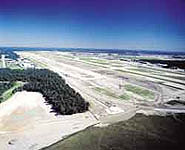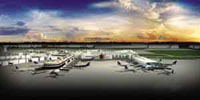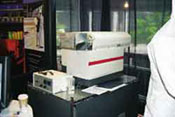 |
| SCREENING FOR THE FUTURE Airports such as Oakland's have time to incorporate baggage screening requirements into expansion planning. (Photo courtesy of the Port of Oakland) |
At Boston's Logan Airport, crews are driving some 170 piles to a depth of up to 130 ft and ordering steel beams for 90,000 sq ft of additional space to the existing terminal in a $106-million project. This would not be an unusual job for an airport undergoing a $4.4-billion modernization program except that this particular project might not have happened if not for Sept. 11.
The airport earlier this month also received a record of decision approving a new runway, a crucial step in an almost 30-year struggle to increase capacity to save some 90,000 hours a year in flight delays. Logan is a model of the present and future challenges facing aviation construction-building for security while anticipating the return of capacity needs. "We have a little bit for everybody," notes Chris Brady, director of capital programs for the modernization program.
Logan is striving for the status of being the first U.S. airport-and perhaps one of few-to be 100% compliant with new requirements calling for baggage explosion detection systems (EDS) to be in service by Dec. 31, issued by the Transportation Security Administration. "We're making the commitment to meet the deadline, and even if it changes, we will meet it," says Terry Rookard, project manager at Logan for DMJM+Harris, New York City, which also is part of a team working with TSA.
 |
| CAPACITY Runways and terminal expansions anticipate renewed traffic. (Photo courtesy of CH2M Hill) |
But who will pay for the infrastructure changes? "It's going to [be an] interesting debate for years to come," says Rookard. Industry officials agree that just about every airport will likely seek reimbursement from the federal government for extra costs incurred now. But security improvement money comes from the same Airport Improvements Grants that would have been used for capacity-related work in a pre-9/11 world.
Security has eclipsed capacity as the top priority for airport builders and planners in the U.S., but the capacity issue will have to be addressed at some point in the future as air travel rebounds. "The capacity problem has not gone away, but traffic had dropped and the political scene changed," says John Storms, vice president for aviation services in the Denver office of Carter & Burgess. "We have a chance to get environmental studies done and programs going now, because further down the road we'll get back to the same capacity problems."
While the new TSA scrambles to staff up, aviation officials are reshaping master plans and redesigning projects to be flexible and ready to accommodate whatever structural requirements are needed in the future.
 |
| KANSAS Airport work schedule increased by three months. (Photo courtesy of KCI) |
Newly hired TSA security director James Blair says it will be "an ongoing process to accommodate new technology as it emerges." He says TSA has technical people working with airports to review security criteria and infrastructure planning, but he offers no details. doubts. Unlike Logan, more than 30 U.S. airports have expressed doubts about the feasibility and practicality of meeting the Dec. 31 deadline. "The EDS machines being used now are like a mainframe computer, when in a few years you will have a desktop," says Gerry FitzGerald, president of PB Aviation, New York City. "When Congress passed legislation last fall, the expectation was that all baggage be X-rayed. Now, it's either X-ray or trace detection."
In Tulsa, a new 90,000-sq-ft addition to the terminal will be ready for EDS machines, but "if the TSA comes back with a trace detection system, we'll have space to accommodate that as well," says Ron Coker, managing director for Atkins Benham, Oklahoma City, lead architect-engineer. He notes that each of the six EDS machines slated for Tulsa requires a 15 x 30-ft footprint and will require some $26 million in related infrastructure work.
The security regulations forced design changes at Kansas City Airport's $229-million terminal improvement project and pushed the completion date back three months to Sept. 2004. The HNTB-led design includes gutting three terminals and adding 150,000 sq ft of new terminal space. GNT Conveyor, Tavares, Fla., is installing an $8-million baggage-handling system "according to plans approved prior to 9/11," but changes could be forthcoming, says Bret Pilney, vice president with Burns & McDonnell, the Kansas City-based terminal program manager. "We're waiting to see what TSA is going to do."
"Because of where we were in the construction process on Sept. 11, we were able to continue on with much of the project while we redesigned certain elements to meet new requirements," says Russ Widmar, Kansas City's aviation department director. About 65,000 sq ft of sidewalk space is being converted into interior departure lounges by using glass-encased "bumpouts." Glass wall height has increased from 8.5 ft to 11 ft and curbside glass walls will now have blast-resistant material.
 |
|
LAX Los Angeles is reshaping plans in light of requirements. (Photo courtesy of American Airlines) |
Oregon's Portland Airport had just completed a three-year terminal reconstruction. Now, it must start over, says Mark Crosby, the airport's general manager of security and public safety. PDX's passenger ticketing level is on the second level, a floor not structurally sufficient for 1-million-lb screening machines. The facility redesign awaits TSA's approval of a proposed baggage-handling system.
Like other airports, San Jose Airport will use a combination of explosive trace detection screening and EDS machines, says Steve Luckenbach, airport spokesman. The airport is awaiting word from Chicago-based Boeing, TSA's lead consultant for baggage screening, on "what our technology response will be," he adds.
But whatever the mix of technologies, meeting the Dec. 31 deadline "is going to be the most daunting challenge," he says. Currently the airport has only two of the $1-million EDS machines, with a projected need for 15 more. To handle an estimated annual 17.6 million passengers by 2010, the airport has just started work on its $3-billion master plan. With a 2008 or 2009 construction completion date, the plan calls for a new central terminal, runway reconstruction, two parking structures and a cargo facility.
URS Greiner's Seattle-based baggage handling division has contracts for screening systems at airports in Seattle, Albuquerque, Tulsa, Oklahoma City, Los Angeles, Baltimore-Washington, Newark and Houston. "They are all in the same boat," says Nebil Ammal, URS airport services director. "No one will meet the Dec. 31 deadline."
Acting swiftly has not paid off. Denver International Airport submitted a proposed redesign to TSA in January and has not yet received federal approval, says Ed Currier, assistant deputy manager of aviation maintenance and engineering. He says there is no way DIA now can meet the Dec. 31 deadline. "The issues here are pretty much the same as with every other airport in the country," he says. "If [TSA] had made a decision by March, we could have installed a system within the deadline." A bright spot for DIA is that it was designed with space for future change. "We cabled the hell out of DIA," says Ginger Evans, Carter & Burgess aviation vice president. "The things that give you flexibility are space and data infrastructure."
U.S. Dept. of Transportation Secretary Norman Y. Mineta has told Congress on behalf of airports that the Dec. 31 deadline is unrealistic. Industry officials believe there is a 50% chance it will be extended. But by how much? Evans notes that before 9/11, the Federal Aviation Administration had a deadline of 2014 for a 100%-compliant baggage screening program. "People were incorporating it into new terminals, but old existing terminals don't have the space and electrical load capacity," she says. Now, "even next year is a very aggressive goal," adds Tim Bond, Carter & Burgess's head of facilities, maintenance and information technology.
William Fife, aviation senior vice president for DMJM+Harris, predicts that "the need for remodeled or new terminals will be accelerated" because current security requirements are costing up to 15% of capacity for efficient processing of passengers. Such is the case at fast-growing Harrisburg Airport, which now will have a brand-new $224-million terminal rather than previously planned $90 million of additions, notes airport director Fred Testa. "It will be a more efficient use of our dollar," he says. But he adds, "A [deadline]delay would save a lot of money, time and mistakes. [The current deadline] forces too many people to make decisions based on inadequate information."
Inevitably, airports will spend millions on Band-Aid interim work. Richard Roth, executive director of airport consultant CTI Technologies Inc., Madison, Ala., warns against going overboard. New machines now in testing promise extremely low false-alarm rates, faster baggage processing and lower cost. "At some point, [airports] may have to redesign for systems that won't need so much room" for baggage screening areas, while checkpoint areas get bigger, he says.
Other impacts loom as well. "We've been studying what would happen if the Dec. 31...deadline didn't get delayed, and we've learned that a passenger would end up waiting four hours to get to their terminal," says Tina Quigley, assistant director of planning and construction for Las Vegas's McCarran Airport. "We are doing an interim solution by sticking the machines in the lobbies. It's a very manual process and every step adds time."
FUTURE. Some airports are ramping up expansion plans again, and others are completely reevaluating them. "We made $80-million in design changes to accommodate security" in October 2002, says Dave Peixotto, capital program director for Oakland Airport. About $5 million in short-term work has doubled the size of checkpoints and moved cargo receiving to a remote location, he says. Minneapolis-St. Paul Airport, in the midst of a $3-billion expansion, slashed its 2002 construction program from $475 million to $150 million, but plans to complete a new 8,000-ft-long, 150-ft-wide runway by 2004, says Dennis Probst, building construction manager for the Metropolitan Airports Commission. It recently obtained TSA approval for funding of its baggage screening system, which will be 75% complete by Dec. 31 and require $38.5 million for a new underground enclosure, utility relocation and other related work.
LAX officials last month announced plans to install a $15-million motion-detection system by the end of 2003. A new $10-billion master plan emphasizes security but scales back a previous $12-billion version. Gone are plans for a new terminal, $700-million ring road, and a $1-billion elevated connector road. Four of nine terminals would be replaced by open-space terminals. Short-term parking and curbside check-in would be relocated to a new transportation center, linked by an automated people mover to the terminals.
 |
| NEW VIEW Airports of the future will look different and they will learn from each. (Photo courtesy of Carter & Burgess) |
Intermodal centers and remote facilities such as these will be in many airports' future, predicts Orlando Cruz, area manager for Pasadena, Calif.-based Parsons, Inc., which is managing Miami Airport's expansion. And more airports are considering common-use facilities, adds Mike McCarron, San Francisco Airport spokesman. "The philosophy worked very well," at SFO's international terminal, a common-use facility where no airline has its own separate facilities, he says. SFO expects to be 100% EDS compliant ahead of the deadline, though it is still waiting from the TSA for approval of a $100-million in-line system for its domestic terminals, he says.
Collaboration abounds."We're learning about things we'd never head of," like blast resistance and surveillance, says Logan's Brady. "Airports in the future will be much different and we must learn from each other."
| Arrival Scheduled: New High-Tech Scanner SECURITY OFFICIALS theoretically will be able to identify a passenger who has been handling explosives simply by scanning the boarding pass with the Boarding Pass Analyzer, developed by Oak Ridge National Laboratory and technical development firm Mass Spec Analytical, Bristol, England.
In development since 2000, the analyzer currently is being used to test people entering the Golden Jubilee celebration at Buckingham Palace and the system is expected to be used in airports in the near future, says Dr. Michael Kuliasha, program director for homeland security at Oak Ridge National Laboratory, Oak Ridge, Tenn. The scanner, the size of a small copy machine, uses spectrometry that can detect a billionth of a gram of explosives, such as TNT and nitroglycerine. Explosives linger on the body for days and are easily transferred from the body to anything it touches, including a boarding pass, says Kuliasha. Even if the person were wearing protective clothes while handling explosives, the analyzer would likely still be alerted. The system would allow airport officials to test all passengers rather than use random testing, and it can scan up to 1000 boarding passes an hour. The Analyzer scans each pass in less than five seconds by shooting a stream of hot air over the pass, desorbing the explosive molecules and separating them from other molecules through the selective nature of negative ionization. Thus, chemicals from perfume, sweat and other sources do not interfere with the scanning. To prevent false alarms, the machine performs two stages of analysis with a tandem mass spectrometer. During tests, the rate of false alarms was 0.2%. The analyzer costs about $250,000, but that is expected to lower as it is commercialized. The project has been funded by the Dept. of Energy. Developers now are working on creating a simple visual system and audible alarm to alert users when explosives are detected. Oak Ridge also plans on allowing security officials to control a threshold setting as another barrier to false alarms. The project team plans to adapt the technology to detect drugs and biological weapons, to analyze breath to determine what disease a patient is suffering from and to test forensic traces of gunpowder or chemicals for law enforcement. |


Post a comment to this article
Report Abusive Comment